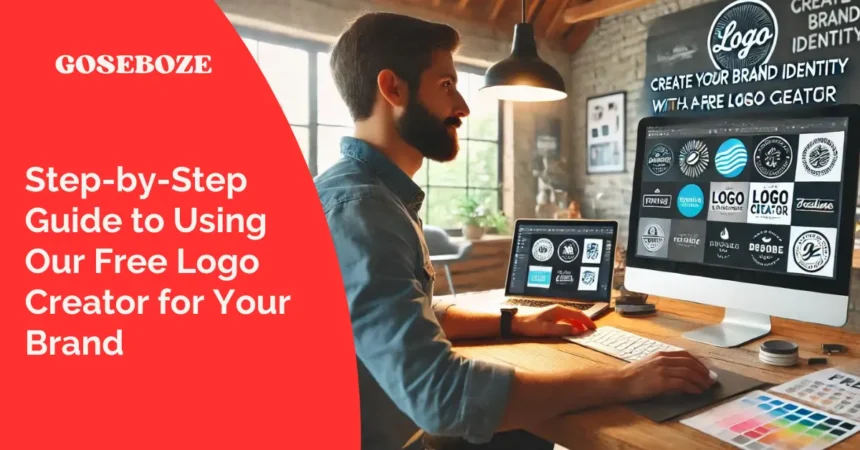Think of your logo as the face of your business—it’s often the first thing people will notice, and it can instantly communicate the essence of your brand.
This small graphic can carry a huge weight in establishing your business identity and differentiating you from the competition, especially for entrepreneurs and small businesses, where every resource counts; getting your logo right is crucial. That’s where a free logo creator comes into play.
These tools are a boon for budget-conscious business owners, offering a pathway to professional-looking logos without the hefty design fees. With intuitive interfaces and many design options, free logo creators simplify the design process while allowing you to create a unique logo.
Step 1: Define Your Brand Identity
Before you dive into designing, it’s vital to have a clear understanding of your brand’s identity. What does your brand stand for? Who are you trying to reach? Your logo should reflect your business’s ethos, aesthetics, and target audience. Start by identifying key aspects of your brand, such as your mission, vision, and values. These elements are the cornerstone of your design process, guiding the visual expression of your brand. Consider the emotions and messages you wish for your logo to communicate. Does your brand lean towards being playful and innovative, or does it tend to be more serious and traditional? Responding to these will assist you in developing a logo that is more impactful and resonates with your target audience.
Step 2: Initial Setup and Planning
Before jumping into the design, there are a couple of preparatory steps to consider. First, if you haven’t already, select a brand name that is catchy and gives a clue of what your business is about. Once you have a name, securing a domain that matches is a smart move in today’s digital-first world. This helps establish a cohesive online presence. Next, engage in a brainstorming session to conjure words that describe your brand’s persona—think adjectives like “innovative,” “reliable,” “friendly,” or “sophisticated.” These words will serve as a guidepost for your logo design. To aid your creativity, you might use mind-mapping tools or simple word association techniques to expand your list and refine your brand’s core characteristics.
Step 3: Choosing the Logo Type
Selecting the right type of logo can significantly influence how your brand is perceived. Here’s a quick rundown of the different types:
- Monogram logos (or letter marks) use initials to create a logo. They are ideal for brands looking to streamline their corporate identity with a minimalistic approach.
- Wordmarks are a straightforward type of logo focused on the company’s name, styled in a unique way. They work well for companies with a distinctive name that can carry the brand alone.
- Pictorial logos involve a graphic image or illustration—think of the apple in Apple’s logo. These are great for brands wanting to be synonymous with a specific image.
- Abstract logos feature geometric forms that don’t necessarily mimic anything recognizable but create a unique brand identity.
Read Also: Debt Collection Management Systems for Small Businesses: What You Need to Know
Each type has its strengths, so choose based on what aligns best with your business model and the traits you brainstormed earlier. Remember, simplicity is key. A simple design ensures your logo remains memorable and effective, easily communicating your brand’s essence without clutter or confusion. Choose a design that can withstand time and be versatile across various mediums.
Step 4: Using the Logo Maker Tool
Ready to dive into the design process? Start by accessing a reliable and versatile free logo creator with Adobe. Once logged in, navigate through the user-friendly interface to get acquainted with its features. Begin by selecting a template that closely matches your brand’s aesthetic. These pre-designed options provide a solid foundation and are typically categorized by industry or style, making it easier to find one that resonates with your brand’s identity. Customize your chosen template by tweaking elements to better align with your brand. This might include changing the layout, modifying icon designs, or adjusting the overall composition to make your logo unique.
Step 5: Customization of Logo Elements
The key to a standout logo lies in its customization. Start with selecting the right icons that represent your brand effectively. Choose typography that complements your brand’s character—a robust serif, a clean sans-serif, or a stylish script. Color schemes also play a crucial role; select colors that reflect the emotions and values of your brand. Utilize the customization features of the logo maker tool to make these adjustments. Experiment with different layouts and fonts, and tweak the color palette until everything aligns perfectly with your brand identity. Each modification should bring your logo closer to what best represents your business.
Step 6: Refining Your Logo
With the initial design in place, it’s time to refine it. Review your logo critically—does it convey your brand’s message effectively? Is it visually appealing across different media? Now’s the time to make iterative adjustments. Seek feedback from colleagues, potential customers, or stakeholders. This external input can be invaluable, offering perspectives you might not have considered. Adjust your logo based on this feedback to ensure it looks good and resonates well with your target audience. Iteration is key in crafting a polished final product representing your brand.
Step 7: Download and Implement
Once you’re satisfied with your logo, it’s time to download it. Ensure you save it in multiple formats to accommodate different uses. PNG and SVG are ideal for digital purposes due to their scalability and transparency support, which are crucial for online platforms. Opt for high-resolution PDF or EPS formats for print to ensure the logo remains crisp and clear in physical copies. Implement your new logo consistently across all business platforms to reinforce brand identity. From your website and social media profiles to business cards and promotional materials, your logo should be prominently displayed to enhance brand recognition and coherence.
Conclusion
Congratulations on creating your new logo using a free logo maker tool! This step-by-step guide has equipped you with the knowledge to harness your creativity and design a logo that captures the essence of your brand. Remember, your logo is more than just a graphic; it’s a crucial component of your branding that can significantly influence your business’s perception and success. As your business grows and evolves, don’t hesitate to revisit and tweak your logo if needed to ensure it continues to align with your brand’s vision and market demands. Embrace the process and watch your brand come to life with a logo you’re proud to showcase!

Morgan Reid, with an MBA and a decade in business strategy, specializes in boosting company performance and operational efficiency. Known for practical insights, Morgan contributes to publications and speaks at industry events, blending expertise with a passion for tech and business innovation.







